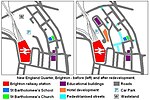Brighton railway station

Brighton railway station is the southern terminus of the Brighton Main Line in England, and the principal station serving the city of Brighton, East Sussex. It is 50 miles 49 chains (50.61 miles, 81.45 km) from London Bridge via Redhill. The station is managed by Southern, which also operates many of the trains. Thameslink and Gatwick Express also operate some trains from Brighton. It was built by the London & Brighton Railway in 1840–41, initially only connecting Brighton to Shoreham-by-Sea, westwards along the coast, in May 1840. It finally connected a year later inland to Haywards Heath and London Bridge in September 1841 via the just-completed Clayton Tunnel; and then in 1846 to the county town of Lewes to the east via the London Road Viaduct. The railway became the London Brighton and South Coast Railway in 1846 following mergers with other railways with lines between Portsmouth and Hastings. With over 17 million passenger entries and exits in 2018/19, Brighton is the seventh-busiest station in the country outside London.
Excerpt from the Wikipedia article Brighton railway station (License: CC BY-SA 3.0, Authors, Images).Brighton railway station
Surrey Street, Brighton Round Hill
Geographical coordinates (GPS) Address Website Nearby Places Show on map
Geographical coordinates (GPS)
| Latitude | Longitude |
|---|---|
| N 50.8288 ° | E -0.1411 ° |
Address
Brighton Railway Station
Surrey Street
BN1 3XP Brighton, Round Hill
England, United Kingdom
Open on Google Maps










